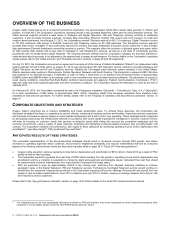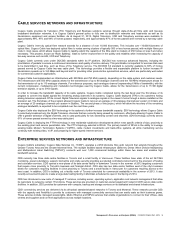Cogeco 2012 Annual Report Download - page 19
Download and view the complete annual report
Please find page 19 of the 2012 Cogeco annual report below. You can navigate through the pages in the report by either clicking on the pages listed below, or by using the keyword search tool below to find specific information within the annual report.18 COGECO CABLE INC. 2012 Management’s Discussion and Analysis (MD&A)
RISKS PERTAINING TO OPERATING COSTS
Cogeco Cable applies itself to keeping its cost of goods sold in check so as to secure continued operating margin growth. The two largest
drivers of cost of sales are network fees paid to audio and video programming service suppliers as well as data transport and connectivity
charges, mostly for Telephony and HSI traffic.
The market for audio and video content services in Canada is characterized by high levels of supplier integration and structural rigidities
imposed by the CRTC’s regulatory framework for broadcasting distribution. While Cogeco Cable has generally been able to conclude
satisfactory distribution agreements with Canadian and foreign programming service suppliers to date, there is no assurance that network fees
will not increase by larger increments in future years. There is also no assurance that programming service suppliers will not change other
material terms of distribution agreements or extend preferences for the distribution of their content to competing distributors, or push for the
distribution of their content over the Internet in the future.
As a result of a final offer arbitration decision issued by the CRTC on July 20, 2012 (Broadcasting Decision CRTC 2012-393), Cable was
required to sign an agreement for the distribution of 29 Bell television programming services on Bell’s terms, and to pay retroactive fee
increases and interest charges going back to January 1st, 2011 for these services. The impact of these increased retroactive fees and charges
has been fully taken into account in the Corporations financial results and statements for the fiscal year ended August 31, 2012. The
agreement with Bell for these 29 services will expire on December 31, 2015.
As a result of Broadcasting Decision CRTC 2012-574 issued on October 18, 2012, which denied entirely Bell’s applications to acquire Astral,
the CRTC has effectively precluded Bell from taking over the control of Astral television programming services that Cogeco Cable distributes as
well to its customers. On October 22, Bell formally requested that the federal government issue a policy direction to the CRTC pursuant to
section 7 of the Broadcasting Act with a view to revisiting this decision and prevailing upon reapplication to the CRTC. The federal government
has indicated that it does not intend to interfere with the decision of the CRTC. It is also possible that Bell will seek leave to appeal the decision
of the CRTC to the Federal Court of Appeal.
Cogeco Cable has however successfully negotiated new multi-year programming service agreements with other large Canadian television
programming service suppliers such as Québecor Media, Shaw Media and Astral without the need for dispute resolution by the CRTC.
Since the markets for data transport and connectivity remain very competitive in North America, Cogeco Cable has negotiated cost effective
arrangements in the past for voice and data traffic. However, as overall traffic increases and capacity on existing broadband
telecommunications facilities becomes more widely used, the Corporation may not be able to secure further cost efficiencies in the future.
RISKS PERTAINING TO INFORMATION SYSTEMS
Flexible, reliable and cost-effective information systems are an essential requirement for the handling of sophisticated service options,
customer account management, internal controls, provisioning, billing and the rollout of new services. The Corporation uses different customer
relations management tools and databases for its operations respectively in Ontario and Québec. There is no assurance that these or other
information systems will be able to adequately meet future business or competitive requirements, that current licensing agreements can be
extended without material changes, or that new agreements can be successfully concluded on a timely and cost effective basis in order to
replace existing systems as, if and when needed.
RISKS PERTAINING TO DISASTERS AND OTHER CONTINGENCIES
The Corporation has disaster recovery and business continuity plans for dealing with the occurrence of natural disasters, quarantine, power
failures, terrorist acts, intrusions, computer hacking or data corruption. Cogeco Cable is not insured against the loss of data, hacking or
malicious interference with its electronic communications and systems, or against losses resulting from natural disasters affecting the cable or
fibre network. In Canada, it relies on in-house and third-party service providers for data protection and recovery systems. The Corporation
completed the implementation of a comprehensive business continuity program for its Canadian operations and has tested the implementation
of this plan in Ontario and in Quebec. The emergency plans and procedures that are in place cannot however provide the assurance that the
effect of any actual disaster can and will be mitigated as planned.
FINANCIAL RISKS
Cable telecommunications is a very capital-intensive business that requires substantial and recurring investment in property, plant, equipment
and customer acquisition. Cogeco Cable depends on capital markets for the availability of additional capital that it must deploy to support its
internal and external growth. There is no assurance that future capital requirements will be met when needed, or that the cost to secure such
needed incremental capital will not increase the Corporation’s weighted average cost of capital. The Corporation entered into cross-currency
and interest rate swap agreements to fix the liability for interest and principal payments on certain of its long-term debts. The volatility of global
financial markets may constrain the Corporation’s ability to meet its future financing requirements, both internal and external, increase its
weighted average cost of capital and cause other cost increases from counterparties also faced with liquidity problems and higher cost of
capital.
Cogeco Cable’s debt financing structure involves the borrowing of money from third parties by Cogeco Cable and the subsequent investment
of equity and debt by the Corporation into its direct and indirect subsidiaries. This financing structure requires that Cogeco Cable be able to
receive upstream flows of funds from its subsidiaries through capital repayments, interest payments, dividend payments, management fees or
other distributions that are sufficient to meet its corporate debt obligations. Future changes to corporate tax, currency exchange and other legal
























